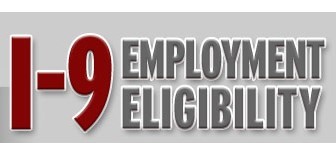Form I-9 requirements
confound small businesses and often result in costly errors, said an HR
consultant testifying before the U.S. House of Representatives’ Small Business
Committee on behalf of the Society for Human Resource Management (SHRM).

“The penalty for
even a single mistake on the I-9 ranges from $216 to $2,126 per form,”
noted Frank Cania, SHRM-SCP, founder and president of driven HR, a Pittsford,
N.Y., HR consulting firm. And it’s easy to make a mistake on an I-9 form.
Not only are employers
prohibited from requiring employees to provide certain documents to prove they
can legally work in the United States, but employers also cannot suggest or
explain which documents are most commonly presented, he stated. Many small
employers nevertheless give new hires a checklist suggesting that the employee
bring documents such as a passport, driver’s license, Social Security card or
birth certificate, though the I-9 instructions prohibit an employer from
offering this information, he said in written testimony.
When a worker’s
employment authorization or employment authorization document expires, an
employer must reverify to ensure the employee is still authorized to work. An
employee may enter a wrong, later date in Section 1, the employee portion of
the I-9, than an employer enters in Section 2, the employer portion. U.S.
Citizenship and Immigration Services states, “The employment authorization
expiration date provided by your employee in Section 1 may not match the
document expiration date recorded by you under List A or List C in Section 2. The
earlier date should be used to determine when reverification is
necessary.” Cania said this requirement presents a “dangerous trap.
An employer tracking the wrong date may be accused of failing to complete a
timely reverification, which is all but certain to be construed as knowingly
continuing the employment of an alien who lacks authorization to work.”
Some employers have tried
innovative ways to comply with I-9 requirements. He noted that one employer
gave a bonus to employees for each I-9 form they submitted with no errors.
“Yet most were submitted with information missing or some other
error,” Cania added.
“In my experience,
the average error rate on I-9 forms by small-business employers exceeds 75
percent,” he said. Consider an employer presenting 100 I-9 forms for
audit. With a relatively low error rate of 9 percent, the minimum fine likely
to be assessed adds up to $1,944 (nine times $216). With an error rate of 50
percent, the penalties may total $106,300 (50 times $2,126). And an error rate
of 75 percent would result in fines of $159,450 (75 times $2,126) or
more.
Other Burdensome Paperwork
The I-9 form is just one
example of burdensome paperwork for small employers, he noted. The Affordable
Care Act requires employers to provide employees with one of two forms.
Self-insured employers with fewer than 50 employees must distribute Form 1095-B (used to report health
insurance information to the Internal Revenue Service and taxpayers about
individuals who are covered by minimum essential coverage). Employers with at
least 50 employees must complete Form 1095-C (furnished to any
full-time employee of a large employer to show employer-provided health
insurance offer and coverage).
Small businesses often
think the reporting requirement for Form 1095-C is an annual average rather
than a monthly one, he said. “This commonly made and honest mistake
required one of our clients to reissue every employee’s form to avoid a
potential IRS fine,” Cania said.
Burdens are not lower due
to the Paperwork Reduction Act (PRA) of 1980, testified Sam Batkins, director
of regulatory policy for the American Action Forum, a Washington, D.C., think
tank that promotes smaller government. “In 1997, after amendments to the
PRA, the cumulative burden was 6.9 billion hours. Today, it stands at 11.6
billion hours. Small businesses are particularly affected, with 3.3 billion
hours of compliance burdens and $111 billion in costs,” he said. For
perspective on the 11.6-billion-hour figure, that is approximately 35 hours for
every man, woman and child in the United States. “That is a workweek
dedicated simply to filling out federal forms and retaining information for federal
regulators,” he said.
Compliance with I-9 forms
is one of many legal items that small businesses may struggle with. Why try to
do it on your own, waste time and money, when you can partner with a business
of HR experts to help? Converge HR Solutions can save your company from costly
mistakes and useless days doing forms, by offering expert advice and a helping
hand. For all of your HR needs, visit https://convergehrsolutions.com/.
Contact us directly at info@convergehrsolutions.com or
610-296-8550.
Article source: https://www.shrm.org/resourcesandtools/legal-and-compliance/employment-law/pages/paperwork-burdens.aspx


0 Comments